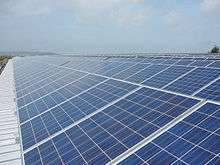Solar power in Maine

Solar power in Maine on rooftops can provide 60% of all electricity used in Maine with 6,300 MW of solar panels. Maine and Vermont are tied for the second highest in the country, behind California, for rooftop solar potential.[1] A 2012 estimate suggests that a typical 5 kW system costing $25,000 before credits and utility savings will pay for itself in 14 years, and generate a profit of $24,683 over the rest of its 25-year life.[2]
Net metering is available to all consumers for up to at least 100 kW generation. Excess generation is rolled over each month but is lost once each year.[3] Maine is given a B for net metering and a B for interconnection.[4]
In October 2007, Maine's largest solar array was the 15.12 kW solar array installed at Maple Hill Farm in Hallowell for $166,000,[5] which through June 11, 2012 has generated 73,416 kWh.[6] Since then average solar costs have dropped substantially, and continue to decline.
In 2011 Maine's largest solar array, 41 kW, was installed on the roof of a new, LEED Platinum grocery store in Augusta.[7][8] A 500 kW system is proposed for otherwise unusable land at the former Loring Air Force Base.[9]
A 9.9 MW solar farm is proposed for Monroe, to be built in 2016.[10]
Installed capacity
Solar insolation in Maine is roughly 33% greater than Germany, the leader in solar installations in 2012.[11]

|
| Grid-Connected PV Capacity (MW)[13][14][15][16][17][18][19][20][21] | |||
|---|---|---|---|
| Year | Capacity | Installed | % Change |
| 2007 | 0.2 | ||
| 2008 | 0.3 | 50% | |
| 2009 | 0.3 | 0% | |
| 2010 | 0.5 | 0.2 | 67% |
| 2011 | 1.1 | 0.6 | 120% |
| 2012 | 2.8 | 1.7 | 154% |
| 2013 | 5.3 | 2.5 | 89% |
| 2014 | 12.7 | 7.4 | 140% |
| 2015 | 19.4 | 6.7 | 53% |
See also
References
- ↑ Rooftop Solar Photovoltaic Technical Potential in the United States
- ↑ Maine
- ↑ Maine Net Metering
- ↑ Freeing the grid
- ↑ Maine’s Largest Solar Array Built at Maple Hill Farm in Hallowell
- ↑ Solar Savings
- ↑ Hannaford set to open greenest grocery store
- ↑ LEED Platinum Hannaford in Augusta, Maine
- ↑ Loring officials envision solar farm on otherwise unusable brownfield
- ↑ Maine’s largest solar farm expected to go online in 2016
- ↑ Maine Solar Energy FAQ’s
- ↑ "PV Watts". NREL. Retrieved 11 June 2012.
- ↑ Sherwood, Larry (August 2012). "U.S. Solar Market Trends 2011" (PDF). Interstate Renewable Energy Council (IREC). p. 16. Retrieved 2012-08-16.
- ↑ Sherwood, Larry (June 2011). "U.S. Solar Market Trends 2010" (PDF). Interstate Renewable Energy Council (IREC). Retrieved 2011-06-29.
- ↑ Sherwood, Larry (July 2010). "U.S. Solar Market Trends 2009" (PDF). Interstate Renewable Energy Council (IREC). Retrieved 2010-07-28.
- ↑ Sherwood, Larry (July 2009). "U.S. Solar Market Trends 2008" (PDF). Interstate Renewable Energy Council (IREC). Retrieved 2010-07-24.
- ↑ Sherwood, Larry (August 2008). "U.S. Solar Market Trends 2007" (PDF). Interstate Renewable Energy Council (IREC). Retrieved 2010-07-24.
- ↑ Sherwood, Larry (July 2009). "U.S. Solar Market Trends 2008" (PDF). Interstate Renewable Energy Council (IREC). p. 16. Retrieved 2010-07-24.
- ↑ Sherwood, Larry (July 2012). "U.S. Solar Market Trends 2012" (PDF). Interstate Renewable Energy Council (IREC). p. 16. Retrieved 2013-10-11.
- ↑ Sherwood, Larry (July 2014). "U.S. Solar Market Trends 2013" (PDF). Interstate Renewable Energy Council (IREC). Retrieved 2014-09-26.
- ↑ Maine Solar